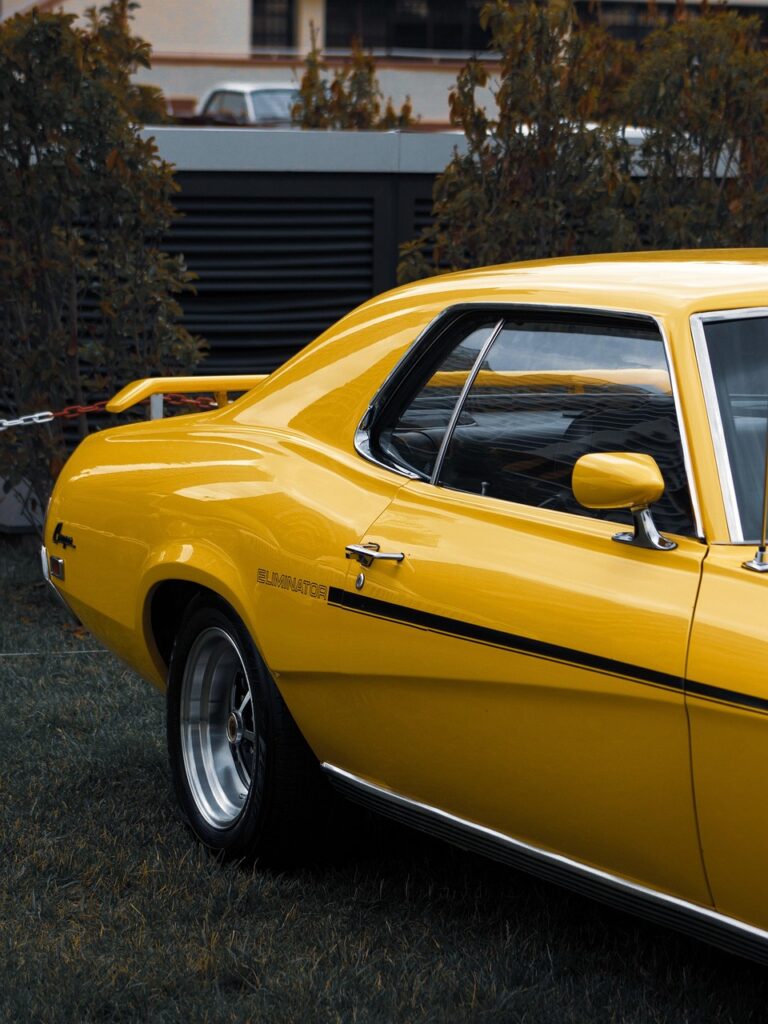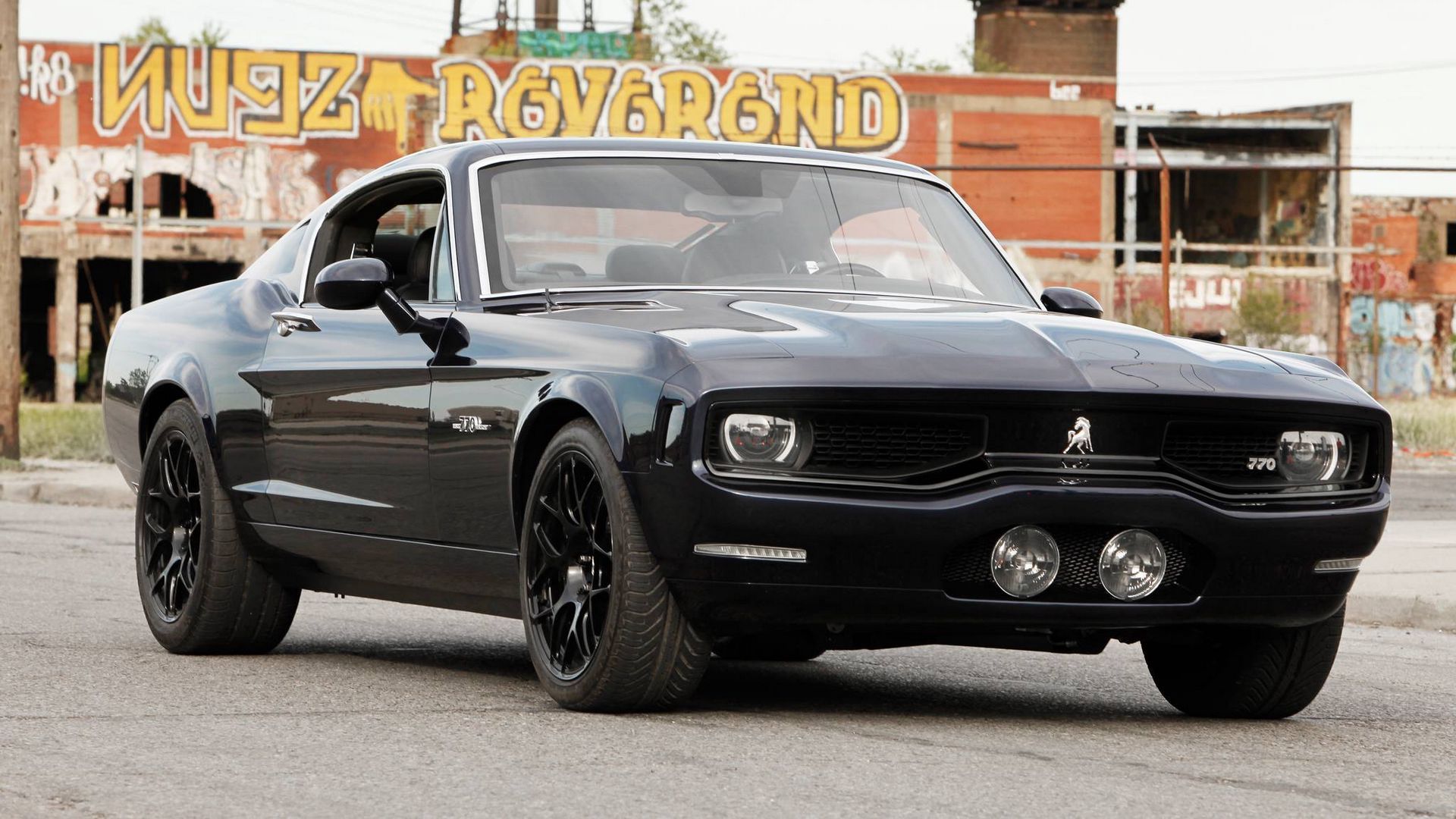
In the annals of automotive history, certain machines transcend their era, defying the relentless march of technological progress. They are the classic muscle cars – titans forged in the crucible of the 1960s and 1970s horsepower wars. Don’t be fooled by their classic curves or understated profiles; these vehicles often pack serious power under the hood, showcasing engineering prowess that can still leave many contemporary performance cars in their wake. They represent a golden age when raw power and brute force were kings, an era where the rumble of a big-block V8 was music to the ears of enthusiasts.
Today, we often benchmark performance against modern marvels like the new Ford Mustang GT, a formidable machine in its own right, known for its low four-second range 0-60 mph sprint. Yet, a select cadre of vintage American iron possesses such formidable capabilities that they can still challenge, and in some cases, outright outmuscle, these modern contenders. The sheer audacity of their design and the unbridled power they unleashed remain a testament to a bygone era of automotive innovation, proving that sometimes, classic truly is better.
We embark on a journey to explore seven such legendary vehicles, machines that look deceptively tame but deliver jaw-dropping performance where it counts. These are not merely collector’s items; they are high-performance benchmarks, a stark reminder that the spirit of the horsepower wars lives on. Their specifications and on-road presence speak volumes, illustrating why the remnants of that golden era remain so potent that they can still outmatch modern sports cars in raw power, including the very Mustang GT that sets a contemporary standard.
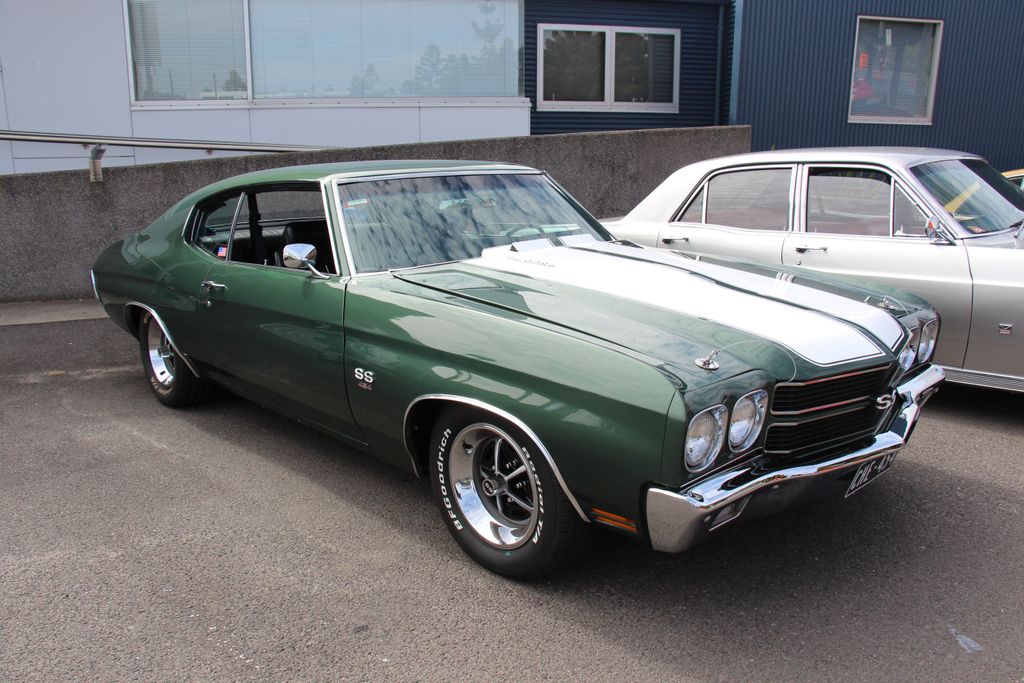
1. **Chevrolet Chevelle SS 454**The 1970 Chevrolet Chevelle SS 454 needs no introduction to anyone with a passing interest in American muscle. It stands unequivocally as the most powerful naturally aspirated big-block V8 muscle car of the 1960s, a designation that cements its status as one of the most desirable classic muscle cars among collectors and enthusiasts alike. This isn’t merely a car; it’s a statement, a rolling testament to an era when sheer displacement and raw power dictated supremacy on the street and strip. Its iconic presence is as undeniable as its performance, embodying the very essence of American automotive might.
With an astonishing output of 450 horsepower and a colossal 500 lb-ft of torque, the Chevelle SS 454 set an entirely new standard for raw performance. These figures were not just impressive for their time; they were utterly dominant, establishing a benchmark that many rivals struggled to meet. The power delivery was ferocious, ensuring that when the accelerator was pressed, the Chevelle launched with an intensity that few could replicate. It was a vehicle designed to intimidate and to conquer, a true king of the road during the height of the muscle car era.
The legendary 454 V8 engine, the heart of this beast, powered not only the Chevelle but also other iconic Chevrolet models, including the El Camino, further solidifying its reputation across the brand’s performance lineup. Its ability to accelerate from 0-60 mph in just 5.4 seconds was blisteringly fast for its time, placing it firmly among the elite. Even decades later, this classic powerhouse still holds its own against many modern muscle cars, a testament to its enduring engineering and the timeless appeal of unadulterated power.
However, acquiring one of these magnificent machines at a reasonable price today is nearly impossible. Due to their exceptional performance, inherent rarity, and profound historical significance, these Chevelle SS 454 models now fetch premium prices on the collector’s market. They are more than just cars; they are cherished pieces of automotive heritage, representing the pinnacle of Chevrolet’s muscle car ambitions.
Car Model Information: 2020 Kia Telluride S
Name: Chevrolet Chevelle
Caption: 1970 Chevrolet Chevelle SS 396 Sport Coupe
Manufacturer: Chevrolet
Production: 1963–1977
ModelYears: 1964–1977
Class: Mid-size
Platform: GM A platform (RWD)
Layout: FR layout
Successor: Chevrolet Malibu
Categories: 1970s cars, All articles needing additional references, All articles that may contain original research, All articles with specifically marked weasel-worded phrases, All articles with unsourced statements
Summary: The Chevrolet Chevelle is a mid-sized automobile that was produced by the Chevrolet division of General Motors (GM) in three generations for the 1964 to 1977 model years. Part of the GM A-body platform, the Chevelle was one of Chevrolet’s most successful nameplates. Body styles included coupes, sedans, convertibles, and station wagons. The “Super Sport” versions were produced through the 1973 model year and Lagunas from 1973 through to 1976.
After a four-year absence, the El Camino was reintroduced as part of the new Chevelle lineup in 1964.
From 1964 to 1969, GM of Canada sold a modified version of the Chevelle that included a Pontiac-style grille, and a LeMans instrument panel, marketed as the Beaumont.
The Malibu was the top-of-the-line model to 1972, and completely replaced the Chevelle nameplate starting with the redesigned, and downsized 1978 model year.
Get more information about: Chevrolet Chevelle
Buying a high-performing used car >>>
Brand: Chevrolet Model: Chevelle SS 454
Price: $20,988 Mileage: 88,231 mi.
Read more about: A High-Octane Flashback: Unveiling 14 Iconic Cars That Revved Up the Unforgettable ’70s
2. **Chevrolet Corvette C3 L88**The Chevrolet Corvette C3 L88 remains one of the most captivating and, indeed, underrated models in the illustrious Corvette lineage. Its mystique is largely due to Chevrolet’s deliberate decision to keep its true capabilities a secret, making it a whispered legend among those in the know. Produced in very limited numbers—only 216 units were manufactured between 1968 and 1969—the L88 Corvette was conceived and marketed as a race-spec vehicle, explicitly built for serious performance and track dominance, rather than casual street cruising. This exclusivity further enhances its allure, transforming it into an exceptionally rare classic cherished by collectors and enthusiasts alike.
For those intimately familiar with the L88, it is universally acknowledged that its official 430 horsepower rating was a severe understatement, a deliberate move by Chevrolet to discourage casual buyers and keep these potent machines in the hands of serious racers. In reality, the engine’s true output was significantly higher, with credible estimates often placing it around 500 horsepower. Some reputable sources, including Hemmings, even suggest it could have been closer to a staggering 550-560 horsepower, pushing it into supercar territory for its time. This concealed power made the L88 a formidable force, capable of outperforming many a competitor in its era.
The L88’s design was singularly focused on performance. It wasn’t just about raw power; it was about delivering that power effectively in a racing environment. The engine itself, a 427 cubic-inch V8, was a marvel of engineering, featuring heavy-duty components and a high compression ratio. Every aspect of the L88 was meticulously engineered for competition, from its beefed-up suspension to its robust braking system, ensuring it could handle the immense power it generated. This single-minded dedication to speed and endurance is what truly sets the L88 apart, making it a testament to Chevrolet’s racing ambitions.
Given its rarity, its race-bred pedigree, and its legendary, understated performance, an L88 C3 Corvette commands a hefty price tag on today’s market, with Classic.com reporting average sales exceeding $300,000. It stands as a pinnacle of American performance engineering, a machine whose true capabilities continue to astonish and inspire. The L88 is not merely a car from the past; it is a timeless performance icon, easily capable of giving many modern performance cars a serious run for their money through its sheer, unadulterated power and heritage.
Car Model Information: 2020 Kia Telluride S
Name: Chevrolet Corvette (C3)
Caption: 1973 Chevrolet Corvette Stingray
Manufacturer: Chevrolet
Aka: Chevrolet Corvette Stingray,(1968–76)
Production: August 1967 – October 1982
ModelYears: 1968–82
Platform: General Motors Z platform
Assembly: St. Louis Truck Assembly,Bowling Green Assembly Plant
Predecessor: Chevrolet Corvette (C2)
Successor: Chevrolet Corvette (C4)
Class: Sports car
BodyStyle: Convertible (car),coupé
Layout: Mid-engine design
Engine: {{cvt,305,cuin,L,1,Chevrolet small-block engine (first- and second-generation)#LG4,V8 engine
Transmission: manual transmission,manual transmission,Turbo-Hydramatic,Automatic transmission
Wheelbase: cvt
Length: {{cvt,182.1,in,mm,0
Width: {{cvt,69.2,in,mm,0
Height: {{cvt,47.8,in,mm,0
Weight: cvt
Designer: GM & Chevrolet design staff,Zora Arkus-Duntov,Bill Mitchell (designer)
Categories: 1970s cars, 1980s cars, All articles with unsourced statements, Articles with short description, Articles with unsourced statements from April 2024
Summary: The Chevrolet Corvette (C3) is the third generation of the Corvette sports car that was produced from 1967 until 1982 by Chevrolet for the 1968 to 1982 model years. Engines and chassis components were mostly carried over from the previous generation, but the body and interior were new. It set new sales records with 53,807 produced for the 1979 model year. The C3 was the second Corvette to carry the Stingray name, though only for the 1969–76 model years. This time it was a single word as opposed to Sting Ray as used for the 1963–67 C2 generation. The name was then retired until 2014 when it returned with the release of the C7.
The most expensive Corvette C3 to sell in history was a 1969 L88 Lightweight, one of only four lightweight L88s to be produced. It was sold by Barrett-Jackson in January 2014 for $2,860,000 (£1,728,941).
Get more information about: Chevrolet Corvette (C3)
Buying a high-performing used car >>>
Brand: Chevrolet Model: Corvette C3
Price: $20,988 Mileage: 88,231 mi.
Read more about: A High-Octane Flashback: Unveiling 14 Iconic Cars That Revved Up the Unforgettable ’70s
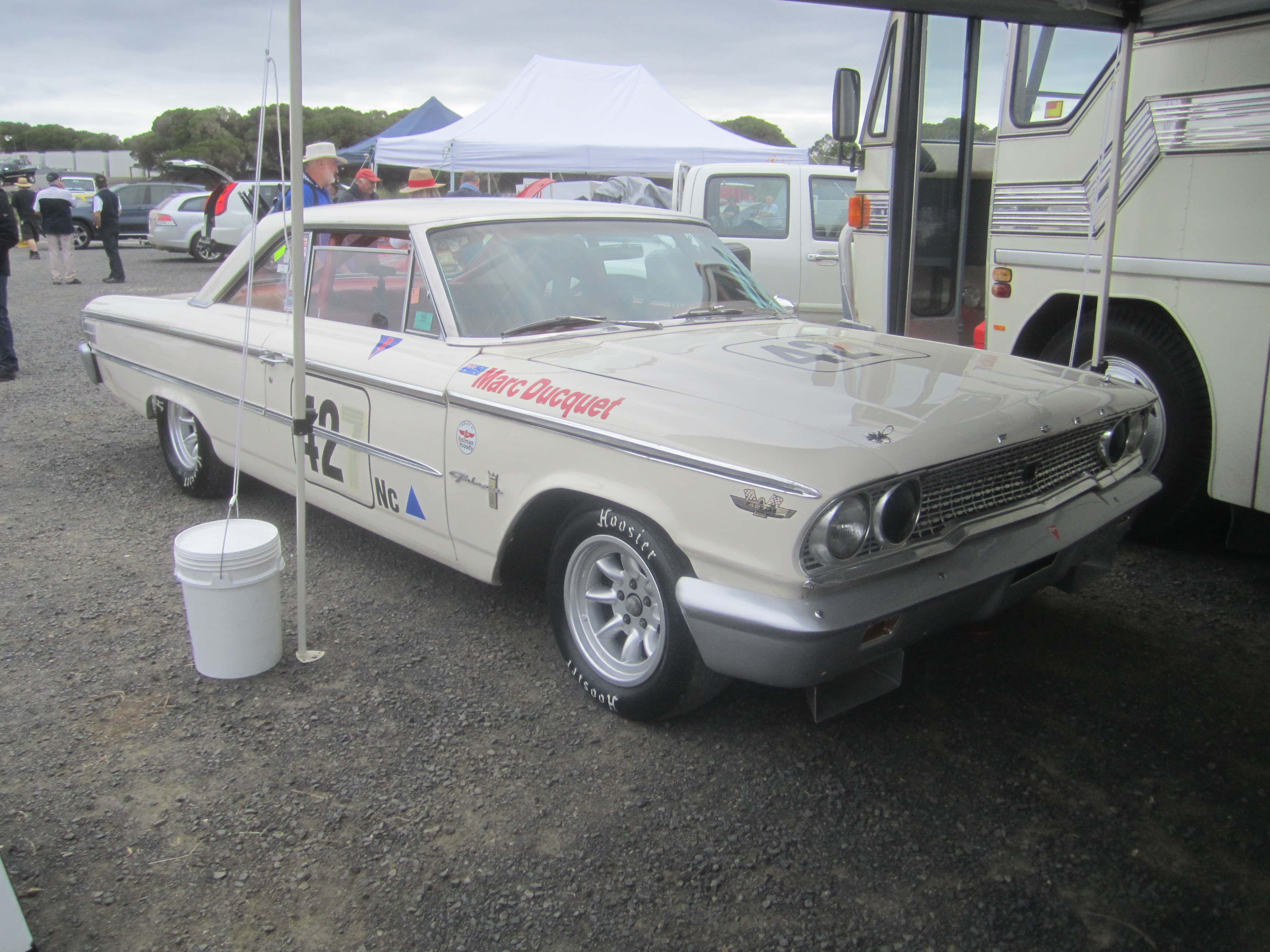
3. **1963-1967 Ford Galaxie 500 R-Code 427**In 1963, Ford expanded the Galaxie 500’s engine lineup with the introduction of a truly special powerplant: a race-bred 427 cubic-inch V8. This engine was specifically designed to meet NASCAR’s stringent homologation requirements, signaling Ford’s serious intent to dominate the highest echelons of motorsports. Its impact on the track was immediate and undeniable, as the Galaxie 427 famously secured the top two positions at the prestigious 1963 Daytona 500, a clear declaration of its formidable capabilities and engineering excellence. This wasn’t just a car; it was a carefully crafted racing instrument, made available to the public to satisfy racing regulations.
For the 1963 model year, the Galaxie 427 was available in two distinct configurations, each catering to different levels of performance demand. There was the Q-Code, producing a robust 410 horsepower, and the even more aggressive R-Code, which pushed out an astounding 425 horsepower and 480 lb-ft of torque. The R-Code variant distinguished itself with a setup that included dual Holley 650 four-barrel carburetors, a clear indicator of its race-oriented design and its intention to deliver maximum power. This level of output from a factory car was nothing short of extraordinary for its time, cementing its reputation as a genuine performance king.
Production numbers for these specialized models were decidedly limited, with only 3,857 R-Code Galaxies built that year, further enhancing their exclusivity and desirability among collectors today. Buyers of this high-performance machine had the option to choose between a convertible, a hardtop, or a sleeker sports hardtop model, the latter offering improved aerodynamics, a critical advantage on the high-speed oval tracks. Each option provided a distinct driving experience, yet all were unified by the immense power lurking beneath the hood.
The legacy of this legendary 427 engine extended far beyond the Galaxie. It later found its way into other iconic high-performance Ford models, notably the formidable 1967 Shelby GT500 and the legendary Shelby Cobra 427, further underscoring its versatility and enduring power. The 427 remained in production until 1967, when it was succeeded by the renowned Ford 428 Cobra Jet, but its impact had already been etched into automotive history. The Galaxie 500 R-Code 427 stands as a powerful testament to Ford’s competitive spirit, showcasing a level of performance that can still command respect and attention, even when lined up against a new Mustang GT.
Echoes of Thunder: Exploring Four More Classic Beasts – the 1967 Dodge Coronet R/T, 1964 Plymouth Belvedere 426 Max Wedge, 1962 Pontiac Catalina Super Duty, and the Legendary 1963 Shelby Cobra – and How Their Engineering Prowess Continues to Challenge Modern Muscle, Including the Latest Mustang GT.
Car Model Information: 2020 Kia Telluride S
Name: Ford Galaxie
Caption: 1963 Ford Galaxie 500 4-Door Sedan
Manufacturer: Ford Motor Company
Production: 1958–1974 (United States),1964–1968 (Australia),1967–1983 (Brazil)
ModelYears: 1959–1974
Assembly: Homebush West,Australia,São Paulo,Brazil
Class: Full-size
Layout: FR layout
Predecessor: Ford Fairlane (Americas)
Successor: Ford LTD (Americas)
Categories: 1960s cars, 1970s cars, All articles with unsourced statements, Articles with short description, Articles with unsourced statements from February 2010
Summary: The Ford Galaxie is a car that was marketed by Ford in North America from the 1959 to 1974 model years. Deriving its nameplate from a marketing tie-in with the excitement surrounding the Space Race, the Galaxie was offered as a sedan within the full-size Ford range throughout its production run. In the full-size segment, the model line competed against the Chevrolet Impala and Plymouth Fury.
The model line was assembled by Ford in multiple sites across the United States; four generations of the model line were produced. The Galaxie was also produced locally by Ford Australia and Ford Brasil, adopting commonality from the third-generation 1965 design.
Get more information about: Ford Galaxie
Buying a high-performing used car >>>
Brand: Ford Model: Galaxie 500
Price: $20,988 Mileage: 88,231 mi.

4. **1967 Dodge Coronet R/T**The roar of a HEMI engine has always signified power and dominance, and the 1967 Dodge Coronet R/T is a prime example of this legendary lineage. Bearing the revered HEMI badge, this machine emerged from the 1960s as a true force, encapsulating the raw, unadulterated strength that enthusiasts crave. Its very name, R/T, an abbreviation for Road/Track, suggested a dual nature, equally at home dominating the asphalt or challenging the quarter-mile. For anyone who appreciates the pinnacle of American performance engineering, the Coronet R/T, especially with its formidable 426 HEMI, stands as an indisputable icon.
Affectionately known as “The Elephant” due to its colossal size and heavy cast-iron construction, the 426 HEMI V8 was an engineering marvel. Weighing in at nearly 800 pounds, this powerplant was not merely a large engine; it was a carefully crafted instrument of speed, delivering a consistent 425 horsepower and a thumping 480 lb-ft of torque. This immense output wasn’t exclusive to the Coronet; it powered a pantheon of Mopar legends, including the Plymouth Road Runner, HEMI ‘Cuda, and Dodge Charger R/T, solidifying its place in the annals of motorsport history as a staple in NASCAR races and even driven by iconic figures like Richard Petty.
What truly sets the Coronet R/T apart is its often-overlooked high-performance package. While the HEMI was undoubtedly its crowning glory, Dodge didn’t stop there. Models offered with the 426 HEMI option between 1966 and 1969 came equipped with a meticulously sport-tuned suspension and robustly upgraded brakes, ensuring that this beast could not only accelerate with authority but also handle and stop with surprising competence for its era. It proved to be a comprehensively engineered performance vehicle, rather than just a straight-line bruiser, offering a dynamic driving experience that belied its heavy engine.
The Coronet R/T’s capabilities extended beyond the street, making a significant mark on the track. A HEMI-powered Coronet R/T, piloted by the legendary David Pearson, secured victory in the prestigious 1968 NASCAR Grand National Championship. This triumphant feat underscored its racing pedigree and validated its comprehensive design as a true competitor. Even against a modern Ford Mustang GT, the Coronet R/T, with its proven HEMI power and balanced performance package, remains a formidable contender, offering an authentic, visceral driving experience that modern machines often strive to replicate.
Car Model Information: 2020 Kia Telluride S
Name: Dodge Coronet
Caption: 1967 Dodge Coronet R/T
Manufacturer: Dodge
Production: 1949–1959,1965–1976
Class: Full-size
Predecessor: Dodge Custom
Successor: Dodge Dart
Layout: FR layout
Categories: 1950s cars, 1970s cars, All articles with dead external links, All articles with unsourced statements, Articles with dead external links from June 2016
Summary: The Dodge Coronet is an automobile that was marketed by Dodge in seven generations, and shared nameplates with the same bodyshell with varying levels of equipment installed. Introduced as a full-size car in 1949, it was the division’s highest trim line and moved to the lowest level starting in 1955 through 1959. The name was reintroduced on intermediate-sized models from the 1965 until 1976 model years. Muscle car versions were available starting in 1965 with the 383 and 426 wedge cu in (7.0 L) Chrysler RB engine, followed in 1966 by the powerful 426 cu in (7.0 L) Chrysler Hemi. Other performance models included the “Superbee”, and featured, the 383 cu in (6.3 L) Magnum, among other engine options. The nameplate “coronet” is a type of crown worn by royalty.
In the 1980s, the Coronet was used on Dodge models marketed in Colombia.
Get more information about: Dodge Coronet
Buying a high-performing used car >>>
Brand: Dodge Model: Coronet R/T
Price: $20,988 Mileage: 88,231 mi.
Read more about: A High-Octane Flashback: Unveiling 14 Iconic Cars That Revved Up the Unforgettable ’70s

5. **1964 Plymouth Belvedere 426 Max Wedge**Before the legendary 426 HEMI became a household name, Chrysler engineers were already pushing the boundaries of performance with another groundbreaking engine: the 426 Max Wedge. The 1964 Plymouth Belvedere, a car that would eventually evolve into iconic models like the Satellite and Road Runner, was a formidable platform for this early powerhouse. This pre-HEMI era Belvedere, especially in its high-performance configuration, provided enthusiasts with an exhilarating taste of what was to come, a testament to Chrysler’s relentless pursuit of speed during the burgeoning horsepower wars.
The heart of these potent Belvederes was the 426 cubic-inch Max Wedge V8, a brute of an engine that pumped out an impressive 425 horsepower and a substantial 480 lb-ft of torque. These figures placed it squarely at the forefront of performance for its time, making the 1962-1964 Belvedere a serious threat on both the street and the strip. Its aggressive power delivery and robust construction made it an instant favorite among drag racers, who quickly recognized its immense potential for dominating the quarter-mile.
While sharing the same displacement, it’s crucial to understand that the Max Wedge 426 and the iconic HEMI 426 are fundamentally distinct engines. The key differentiator lies in their combustion chamber design. As its name suggests, the HEMI employs a hemispherical combustion chamber, celebrated for its efficiency and ability to flow large volumes of air and fuel. In contrast, the Max Wedge utilizes a wedge-shaped design, a testament to earlier but equally effective engineering principles that allowed for high compression ratios and impressive power output.
Chrysler’s strategic deployment of the Max Wedge engine preceded the widespread fame of the HEMI, illustrating a progressive approach to performance development. The Max Wedge represented a pivotal moment, a bridge between conventional V8 technology and the revolutionary HEMI. However, despite its significant contributions and raw power, the Max Wedge’s era was eventually eclipsed by the advent and popularization of the HEMI. It remains a historic and powerful engine, a true precursor whose spirit and performance capabilities are still celebrated by enthusiasts who appreciate its pioneering role in the golden age of muscle, and certainly capable of making a modern Mustang GT think twice.
Car Model Information: 1967 Plymouth Belvedere II Convertible
Caption: 1958 Plymouth Belvedere 2-door hardtop
Name: Plymouth Belvedere
Manufacturer: Plymouth (automobile)
Production: 1954–1970
Predecessor: Plymouth Cranbrook
Successor: Plymouth Satellite
Class: Full-size
Layout: FR layout
Categories: 1960s cars, 1970s cars, Articles with short description, Cars introduced in 1954, Commons category link is on Wikidata
Summary: The Plymouth Belvedere is a series of American automobile models made by Plymouth from 1954 until 1970.
The Belvedere name was first used for a new hardtop body style in the Plymouth Cranbrook line for the 1951 model year. In 1954, the Belvedere replaced the Cranbrook as the top trim and became a full model line with sedans, station wagons, and convertible body styles. The Belvedere continued as Plymouth’s full-sized car until 1965 when it became an intermediate. It was replaced after the 1970 model year by the Satellite, a name originally used for the top-trim level Belvederes.
The word belvedere is Italian for “beautiful sight” or “fair view.” Chrysler also had the Belvidere Assembly Plant in Belvidere, Illinois, which began vehicle production in 1965. However, the Plymouth Belvedere was never assembled there.
During the 1950s and 1960s Chrysler Canada built the Belvedere for Commonwealth export markets such as New Zealand, India, and South Africa, in either CKD form or in factory right-hand-drive. Australia’s local Chrysler operation built its own variation of the model until 1960.
Get more information about: Plymouth Belvedere
Buying a high-performing used car >>>
Brand: Plymouth Model: Belvedere
Price: $22,999 Mileage: 78,620 mi.
Read more about: Unearthing the Automotive Unicorns: 9 Muscle Cars So Rare Even Dedicated Collectors Scramble to Find Them
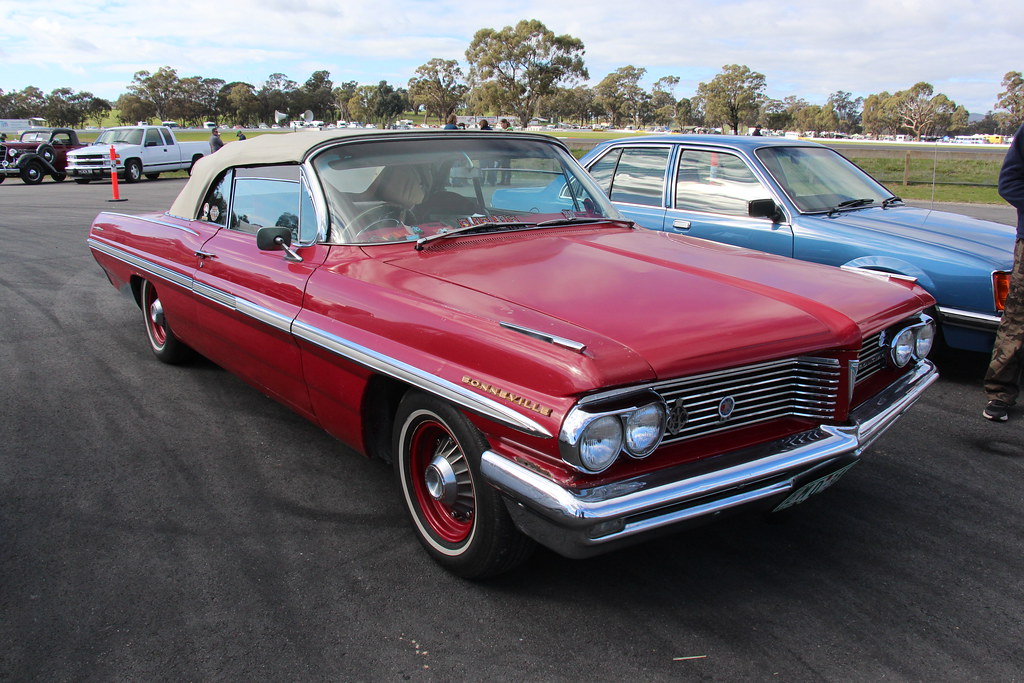
6. **1962 Pontiac Catalina Super Duty**The 1962 Pontiac Catalina Super Duty stands as a unique and often misunderstood titan from an era just before the official muscle car segment was established. It was a machine born not for leisurely cruises, but for outright competition, embodying Pontiac’s ambitious Super Duty performance program. This dedication to racing was evident in every aspect of its design, aimed squarely at dominating both NASCAR oval tracks and NHRA quarter-mile drag strips, making it a pivotal figure in early American motorsport history.
At the core of the Catalina Super Duty’s formidable prowess was a special 421 cubic-inch V8 engine. This powerplant was engineered for extreme performance, delivering an impressive 405 horsepower and 425 lb-ft of torque. Its capabilities were not just theoretical; as documented by Hemmings, this remarkable engine lived up to every expectation, securing an astonishing victory in 30 out of 52 races during the 1961 Grand National series. Such a dominant track record unequivocally cemented its status as an iconic and highly effective racing engine, proving Pontiac’s engineering mettle.
To meet NASCAR’s stringent homologation requirements, this potent Pontiac 421 Super Duty V8 was meticulously incorporated into a limited number of special production models, one of the most notable being the lightweight Catalina Super Duty. Despite its race-bred components and track-focused performance, this car remained fully street-legal, an astonishing feat that allowed it to terrify rivals on public roads while still complying with regulations. This dual nature made it an incredibly desirable and historically significant classic, a true wolf in street clothing.
A fascinating technical detail that often surprises enthusiasts is that the Super Duty V8, despite its considerable displacement, is not classified as a big block. Pontiac, uniquely among major American manufacturers, never produced a true big-block V8 throughout its entire history. This distinction underscores the ingenuity of their engineers, who managed to extract monumental power and torque from what was technically a small-block design, further elevating the mystique and engineering marvel of the 1962 Catalina Super Duty. It’s a testament to the fact that brute force isn’t the only path to superior performance, a lesson that still resonates when comparing it to today’s more technologically advanced, yet sometimes less viscerally engaging, machines like the new Mustang GT.
Car Model Information: 1963 Pontiac Catalina Sport Coupe
Caption: 1970 Pontiac Catalina hardtop coupe
Name: Pontiac Catalina
Manufacturer: Pontiac (automobile)
Production: 1950–1981
Platform: GM B platform
Predecessor: Pontiac Chieftain
Successor: Pontiac Bonneville
Class: Full-size car
Layout: FR layout
Categories: 1960s cars, 1970s cars, 1980s cars, All articles needing additional references, All articles with unsourced statements
Summary: The Pontiac Catalina is a full-size automobile produced by Pontiac from 1950 to 1981. Initially, the name was a trim line on hardtop body styles, first appearing in the 1950 Chieftain Eight and DeLuxe Eight lines. In 1959, it became a separate model as the “entry-level” full-size Pontiac.
The Catalina was Pontiac’s most popular model, available in multiple body styles, and served as the donor platform for the popular Pontiac Grand Prix, Pontiac 2+2, Pontiac Ventura, and the Pontiac Safari station wagon.
When the second-generation Pontiac Tempest was introduced in 1964, lessons learned from the Catalina’s introduction of the Grand Prix led to the introduction of the Pontiac GTO, to include the 389 cu in (6.4 L) Pontiac V8.
Get more information about: Pontiac Catalina
Buying a high-performing used car >>>
Brand: Pontiac Model: Catalina
Price: $38,981 Mileage: 38,300 mi.
Read more about: Unleashing the Beasts of ’62: A Deep Dive into 8 Legendary American Muscle Car Grandfathers

7. **1963 Shelby Cobra**The name Shelby Cobra evokes a sense of raw, untamed power and uncompromising performance, and the 1963 Shelby Cobra is where this legend truly began. This iconic roadster represents a masterful fusion of American power and British craftsmanship, a collaboration between the visionary Carroll Shelby and AC Cars. It wasn’t just a car; it was a revolution, born with a singular purpose: to conquer the world’s most challenging race tracks and establish a new benchmark for sports car performance, leaving an enduring legacy that continues to captivate enthusiasts globally.
Central to the Cobra’s unparalleled success was its lightweight body combined with an array of potent engine options from Ford. While early models in 1963 often featured the formidable 289 cubic-inch Ford V8, the true game-changer was the introduction of the legendary Ford 427 FE engine. This powerhouse created an exceptional power-to-weight ratio that allowed the Cobra to unleash astonishing acceleration. The figures speak for themselves: this lightweight beast, equipped with the 427, could rocket from 0-60 mph in a mere 4.0 seconds. This staggering sprint time not only rivaled but often surpassed the capabilities of more sophisticated and significantly more expensive European sports cars of its era, and still holds its own impressively against contemporary performance vehicles, including the current Mustang GT.
Every aspect of the 1963 Shelby Cobra’s design was meticulously engineered for speed and track dominance. It sported an aggressive hood scoop, not merely for aesthetics, but for superior airflow, ensuring the high-performance engines received optimal cooling and oxygen. The side exhaust system was another functional design element, engineered for efficient gas expulsion, contributing to maximum power output. Paired with a precise four-speed manual gearbox, the Cobra offered an immersive and challenging driving experience that connected the driver directly to its immense power and agility. This meticulous attention to performance details made it a formidable force to be reckoned with.
The Shelby Cobra 427 models, stemming from this early lineage, were renowned for delivering over 400 horsepower and achieving top speeds that could exceed 165 mph, performance figures that were truly groundbreaking at the time. Despite its relatively small size, the Cobra consistently punched above its weight, often outperforming much larger and pricier competitors. Its unique blend of lightweight construction, immense power, and unparalleled agility transformed the sports car landscape forever. The 1963 Shelby Cobra’s legacy as an automotive icon is undeniable, a testament to its unexpected speed, incredible agility, and the pure, unadulterated thrill it offers, continuing to be celebrated as a benchmark against which modern performance cars are measured.
Read more about: Beyond Their Time: 15 Legendary Muscle Cars That Still Command the Road
The enduring allure of these classic muscle cars is undeniable. They are more than just powerful machines; they are rolling chronicles of an era defined by audacious engineering and a relentless pursuit of speed. From the visceral roar of a HEMI to the surgical precision of a Shelby Cobra, each vehicle on this list offers a compelling narrative of how raw power, clever design, and a touch of rebellious spirit can create legends that defy the passage of time. As the rumble of these timeless beasts echoes through the generations, they stand as a powerful reminder that some things, especially when it comes to horsepower, truly are built to last, forever challenging the notion that newer always means better. They don’t just ‘smoke’ a new Mustang; they teach it a history lesson.

